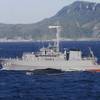In 2000, freight rates turned out at a significantly higher level than during the previous year. On an average basis, tripcharter rates for Capesizes (150,000 dwt) more than doubled to $17,600/day, while rates for modern Panamaxes increased from $7,500 to $11,100/day. For Handymaxes, tripcharter rates went up from $6,900 to $9,200/day. The freight market showed a steady rise through the first three quarters of the year, but softened somewhat during its final three months. The main cause of the firmer freight market was the strong upturn in world economic growth, and particularly in the U.S. The strong U.S. economy combined with imports of finished goods created strong support for industrial production in and exports from the rest of the world. In addition, more extensive imports of grain also meant heavier demand for tonnage.
Bulk Carrier Ship Values
Despite the firmer freight market and rising newbuilding prices during most of the year, R.S. Platou noted only small changes in second-hand ship values. The main reason could be that market participations were aware at a very early stage of the large number of newbuildings scheduled to enter the market in 2001. This probably made them consider any further upside potential in ship values to be limited. Within the OECD area, industrial production rose by five percent over 1999. The U.S. and Japan increased production by five percent, while Western Europe attained about four percent higher output. In Asia outside Japan, production rose about 11 percent. The world steel production increased by seven percent from 788 to 844 tons — an all time high. All world regions showed increased output and among the most important ones we noted that steel output in Japan rose by 13 percent. Other Asian countries produced 4.6 percent more, and Western Europe escalated its production by five percent. In the Former Soviet Union and North America, steel production went up by 13 and by four percent, respectively.
Market Prospects
In its previous report, R.S. Platou suggested a higher utilization rate and firmer freight rates during year 2000. That also proved to be the case. The report, as it turned out though, was too conservative on the demand side. R.S. Platou predicted an increase of from three to four percent, while the end result showed five percent in tonnage demand and six percent in volumes. The fact that the tonnage demand was heavier than expected can to a very large extent be explained by world economic growth stronger than expected, particularly in the U.S. That exerted a very positive influence on Asian and European industrial production and exports. Our fleet scenario suggested an increase of about two percent and this came close to being realized.
The latest predictions for world economic growth in 2001 indicate a moderate increase in world steel consumption on a worldwide basis. There are however, indications (such as falling steel prices) that during the last 12 months steel production has exceeded the actual consumption and consequently there has been some stockbuilding. It is therefore possible that a certain quantity of the steel due to be consumed in 2001 has already been produced and transported to the consumer areas. New coal burning power utilities in Asia are scheduled to become operational in the next few years, and most new projects that were postponed during the Asian economic crisis are now reported to be in progress. Asian coal consumption, as a result, should rise, and it would reason that there would be larger seaborne imports. It is expected that the total seaborne trade will show a moderate increase, and about 20 million dwt of new bulk ships are scheduled to become operational during 2001. Based on the estimated slower growth in tonnage demand and the more plentiful supply, R.S. Platou expects removals from the fleet to escalate in 2001. Taking the age profile into consideration, it would seem very likely that scrapping could be most frequent among the smaller ship sizes. Taking in all elements, the estimate is for tonnage supply to increase by four percent in 2001.
By Bjørn Bodding, R.S. Platou Economic Research a.s., as excerpted from The Platou Report 2001.
Sponsored Content
Lower carbon intensity fuels to support your operations

Subscribe for
Maritime Reporter E-News
Maritime Reporter E-News is the maritime industry's largest circulation and most authoritative ENews Service, delivered to your Email five times per week










